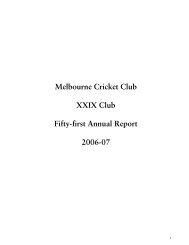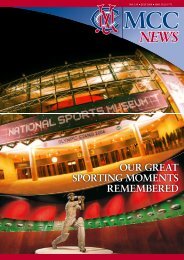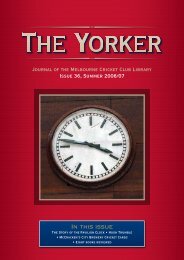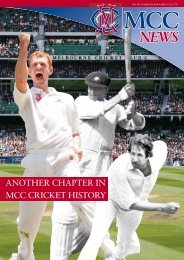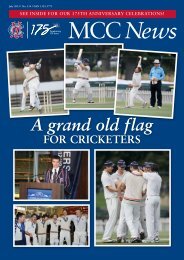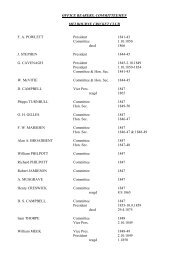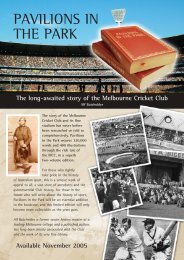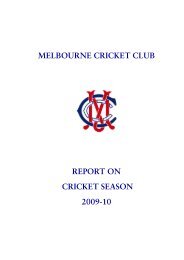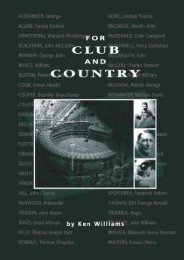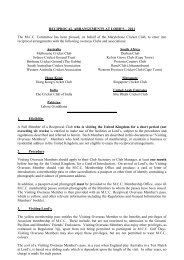Issue 42: Spring 2010 - Melbourne Cricket Club
Issue 42: Spring 2010 - Melbourne Cricket Club
Issue 42: Spring 2010 - Melbourne Cricket Club
Create successful ePaper yourself
Turn your PDF publications into a flip-book with our unique Google optimized e-Paper software.
Late on November 15, Cugnet backed his words with "the most<br />
successful flight in the Commonwealth up to date" when he<br />
"soared" across the Altona property of MCC member (and VRC<br />
committeeman) William Henry Croker. After taxiing down the<br />
paddock, "the aeroplane slipped forward, dipped, then rose, and<br />
shot up to a height of 30ft." Much excitement followed:<br />
Back over the course it had just traversed it came as steadily<br />
as a soaring eagle. The splutter of the engine came nearer,<br />
and as he passed over the heads of the spectators Mr. Cugnet<br />
shot up still higher. In answer to the ringing cheers that<br />
greeted his successful flight, the aviator waved a hand, then<br />
sped on in the direction of Williamstown.After travelling a<br />
mile in under two minutes the aviator took a turn to the north,<br />
then came back again along a two-mile course, during which<br />
he reached the height of between 100ft. and 200ft. Turning<br />
gracefully a mile away to the west, Mr. Cugnet soared over a<br />
clump of trees, swooped down and cleared a fence, and then<br />
coming back to the middle of the paddock again ended his<br />
brilliantly successful flight by landing safely.<br />
After "a continuous flight of seven minutes" that covered "a<br />
distance of slightly over six miles", the Frenchman had landed<br />
"with all the Australian aviation records in his possession." 12<br />
Cugnet's achievement aroused enormous interest, leading to the<br />
promise of "a public trial of the aeroplane" on the Altona Estate<br />
on Saturday November 26. The occasion would also boast a<br />
military band and several refreshment marquees.<br />
The Victorian Railways and a steamship company made "special<br />
arrangements … for the carrying of visitors to the aerodrome."<br />
The Argus noted that the flight would be "under the patronage<br />
of both the Federal and State Ministry, and other distinguished<br />
citizens”. In addition, Glen's music warehouse offered a hundred<br />
tickets for the vice-regal reserve at a guinea each.<br />
Thousands flocked to Altona "to witness what was announced<br />
as the first public air flight in Victoria". Since the occasion was<br />
regarded "as of such importance as to warrant the christening<br />
of the flyer", William Morris Hughes was invited to perform<br />
the honours. Naming the aircraft "Australia", the acting Prime<br />
Minister "smashed a bottle of champagne, which poured over<br />
himself and he splashed the machine with a few drops."<br />
Unfortunately, as the breeze changed from "a light southerly<br />
into a sharp wind coming in freshening gusts", Cugnet decided<br />
that "the wind was so strong that any attempt to fly would have<br />
been to risk serious injury to the only machine … we have in<br />
Australia." The result was that the crowd became "bad tempered<br />
and sarcastic". Amid "fears for the safety of the machine", Cugnet<br />
reminded the press that he was "not a showman". Instead, his<br />
purpose was "to establish a school of aviation" in Australia.<br />
Nevertheless, he promised "another attempt within a week." 13<br />
The forthcoming Austral Wheel Race therefore presented an<br />
ideal opportunity for Cugnet to advance his cause. On November<br />
29, the MCC committee discussed a letter from Mr McCullagh,<br />
secretary of the <strong>Melbourne</strong> Bicycle <strong>Club</strong>, about the "ascent" of<br />
the Blériot on both days of the Austral Wheel Race.<br />
When asked back in October "to approve of the use of the Ground<br />
for Aeroplane flights", the club had been reluctant to agree "without<br />
further information". Now, by a margin of one vote, and with<br />
the demand for "a proper guarantee", the committee gave their<br />
permission. A day later, the MBC announced that Gaston Cugnet,<br />
"the Blériot flier" would give a display at the MCG on December 3.<br />
Though the promoters would accept no responsibility "should<br />
the weather conditions be unfavourable", an accompanying<br />
advertisement promised "The most sensational flight ever<br />
attempted in any part of the universe”. Intending spectators were<br />
also assured that Monsieur Cugnet was "most anxious" not to<br />
disappoint the public, for he "feels that his reputation as an AVIATOR<br />
is at stake." 14<br />
The Frenchman had more than his reputation "at stake". Though<br />
the dignitaries assembled at Altona would have understood<br />
his reasons for not taking to the air, his failure to fly had not<br />
improved prospects for the sale of Blériot machines to the<br />
Australian government. Another such episode would only further<br />
damage the interests that had sent him to Australia.<br />
Awaiting the Flight.<br />
On the first afternoon of the Austral, the crowd of at least 10,000<br />
enjoyed "a mild breeze from the south". As the Argus observed,<br />
"probably not a hundredth of them considered that the breeze …<br />
would be an obstacle to the aviation display." In such conditions, a<br />
common remark among the spectators was, "If the thing can't go<br />
up on a day like this, what is the use of it?" Around 5.30, with the<br />
cycling events completed, signs of impatience appeared:<br />
"Come on, monsieur!" "Let her go!" shouted men at the eastern<br />
end of the enclosure, to which the aeroplane was nearest.<br />
In some quarters, "a grumble of discontent" could be heard. By six<br />
o'clock, conditions had worsened, with the flag over the Pavilion<br />
floating "well out in the breeze". In these early years of aviation,<br />
wind was a fearsome enemy for pilots. In a frail Blériot, the risk<br />
could certainly not be ignored. (In 1927, after his epic transatlantic<br />
flight, Charles Lindbergh would tell Monsieur Blériot that he<br />
"wouldn't go up in your aeroplane for even one minute.") 15<br />
Nevertheless, windy though it was, Cugnet decided to fly. Though<br />
he later admitted that "it would be dangerous", he "was anxious<br />
not to disappoint the spectators" and he simply had to seize this<br />
precious opportunity to display his monoplane's merits. At about<br />
6.30, to the strains of La Marseillaise, he appeared on the arena.<br />
Usually, Cugnet "had a stern, sad expression" 16 but he was now<br />
skipping "along like a school girl". The Blériot's engine was<br />
started, and soon the aeroplane was running forward "on its three<br />
pneumatic tyred wheels towards the western end of the enclosure":<br />
After wheeling for about 40 yards, it rose into the air. But it had<br />
flown only some 40 yards at a height of about 15ft., when it<br />
wheeled to the left, stopped, and alighted again on the grass …<br />
The monoplane was then taken back to the eastern end of the<br />
arena, "and again faced westward":<br />
This time the aeroplane ran on its wheels to within about<br />
80 yards of the western boundary of the enclosure, heading<br />
outward for a gap between the new members' stand and the<br />
20 The Yorker - <strong>Spring</strong> <strong>2010</strong>



